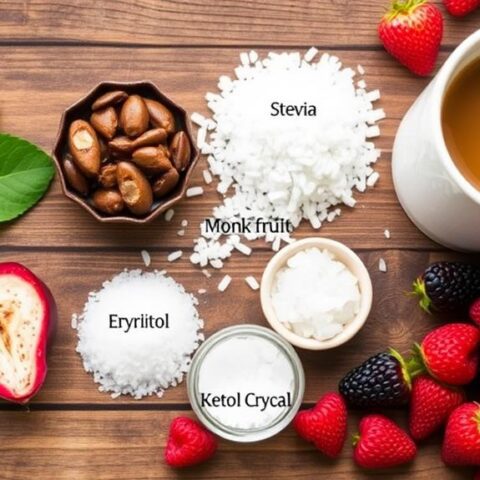
Smart low-carb food choices for diabetics include non-starchy vegetables like leafy greens, broccoli, and cauliflower, along with protein-rich options such as lean meats, fish, and eggs. Greek yogurt, cottage cheese, and nuts provide essential nutrients while keeping carbohydrates low. Portion control and meal timing play essential roles in blood sugar management, with tools like measuring cups helping regulate intake. Understanding food labels and proper meal planning reveals additional strategies for ideal diabetes management.
Key Takeaways
- Non-starchy vegetables like leafy greens, broccoli, and cauliflower are excellent low-carb choices high in fiber and nutrients.
- Lean proteins including chicken, fish, eggs, and tofu provide essential nutrients without impacting blood sugar levels.
- Healthy fats from avocados, nuts, and olive oil help slow digestion and maintain stable blood glucose levels.
- Greek yogurt and cottage cheese offer protein-rich options with minimal carbohydrates for snacks or meals.
- Fresh berries are lower in carbs than other fruits and provide antioxidants while having minimal impact on blood sugar.
Understanding Blood Sugar Management Through Food Choices
When managing diabetes effectively, understanding the relationship between food choices and blood sugar levels becomes essential for maintaining ideal health. Low-carb foods, including non-starchy vegetables and healthy fats, play a vital role in diabetes management by minimizing blood glucose fluctuations.
Additionally, incorporating fiber-rich foods and low-glycemic index foods helps stabilize blood sugar levels while providing essential nutrients. The ketogenic diet greatly reduces blood glucose levels and stabilizes HbA1c, preventing harmful blood sugar spikes.
The key to successful blood sugar management lies in careful attention to portion sizes and selecting foods that digest slowly. While whole grains and legumes contain more carbohydrates, their high fiber content makes them suitable options when consumed in moderation.
Regular monitoring of blood glucose responses to different foods allows individuals to fine-tune their dietary choices, creating a sustainable and balanced approach to diabetes control.
Essential Non-Starchy Vegetables for Diabetic Diets
For diabetics seeking ideal blood sugar control, incorporating a variety of non-starchy vegetables begins with nutrient-rich leafy greens like spinach and kale, which offer essential vitamins and minerals while maintaining low carbohydrate levels. Cruciferous vegetables, including broccoli and cauliflower, stand out as particularly beneficial choices due to their high fiber content and potential anti-inflammatory properties. The most effective preparation methods for these vegetables include steaming, roasting, or light sautéing, which preserve nutrients while enhancing flavor without adding unnecessary fats or calories. Incorporating these vegetables into a keto diet can help improve insulin sensitivity and reduce HbA1c levels, providing additional benefits for managing Type 2 diabetes.
Leafy Greens and Benefits
Among the most valuable foods for diabetics, leafy greens stand out as essential components of a healthy, low-carb diet. These nutrient-rich vegetables, including spinach, kale, and collard greens, play a significant role in managing blood sugar levels while providing substantial dietary fiber intake.
Their low calorie and carbohydrate content, combined with high nutritional value, makes them ideal for weight management and overall health.
Key benefits of incorporating leafy greens into a diabetic diet include:
- Rich source of vitamins A, C, K, folate, iron, calcium, and potassium
- Natural aid in blood sugar regulation through fiber content
- Promotes satiety while maintaining low caloric intake
These versatile vegetables can be prepared in various nutritious options, from garlic-sautéed preparations to traditional Southern-style dishes, making them both practical and enjoyable additions to a low-carb diet.
Cruciferous Vegetables Matter Most
While leafy greens offer substantial benefits for diabetics, cruciferous vegetables emerge as particularly important allies in managing blood sugar levels effectively.
Vegetables like broccoli, cauliflower, and Brussels sprouts provide exceptional nutritional value while maintaining a low-carb profile, with just 6 grams of carbohydrates per cup of cooked broccoli.
These powerhouse vegetables are high in fiber and packed with essential vitamins, including C, K, and folate, supporting overall health without compromising blood sugar control.
Their glucosinolate content offers anti-inflammatory properties, while their fiber-rich nature aids in weight management by promoting satiety.
For diabetics following a low-carb diet, cruciferous vegetables represent an ideal choice, delivering vital nutrients and supporting stable blood glucose levels through their unique combination of fiber and beneficial compounds.
Best Vegetable Cooking Methods
The proper preparation of non-starchy vegetables maximizes their nutritional benefits and blood sugar management potential for individuals with diabetes.
Ideal cooking methods preserve essential vitamins while enhancing flavor and nutrient absorption. Steaming, roasting, and sautéing with healthy fats like olive oil are preferred techniques that maintain nutritional integrity.
Key cooking strategies for diabetes management include:
- Quick-cooking methods that preserve vegetable crunch and color
- Adding garlic and herbs for flavor enhancement without extra calories
- Using minimal water to prevent nutrient loss during preparation
For ideal results, avoid lengthy boiling sessions that can diminish nutritional value.
Instead, focus on preparation methods that maintain the vegetables' natural qualities while maximizing the absorption of beneficial compounds through the thoughtful addition of healthy fats.
Protein-Rich Foods That Keep Carbs Low
For individuals managing diabetes, protein-rich foods serve as cornerstone ingredients in maintaining stable blood sugar levels. A variety of protein sources can effectively support low-carb diets while delivering essential nutrients. Lean meats, fish, and eggs form the foundation of these choices, with fatty fish offering additional benefits through omega-3 fatty acids. Nuts and seeds provide healthy fats and plant-based proteins, contributing to a balanced diet for those following a keto lifestyle. Plant-based options and dairy products provide excellent alternatives while keeping carbohydrates in check. Greek yogurt and cottage cheese deliver high protein content with minimal carbs, particularly when choosing unsweetened varieties. Nuts and seeds complement these options by providing healthy fats and protein, though portion control remains vital. While beans and legumes offer valuable nutrition, careful monitoring of serving sizes helps maintain lower carbohydrate intake while benefiting from their protein content.
Healthy Fats and Their Role in Blood Sugar Control
By incorporating healthy fats into a diabetes management plan, individuals can effectively support blood sugar control while gaining numerous nutritional benefits. These fats play a vital role in improving insulin sensitivity and maintaining stable blood sugar levels throughout the day. Sources like avocados, nuts, and olive oil contribute to better glycemic control while supporting weight management through increased satiety. Key benefits of healthy fats for diabetics include: – Enhanced absorption of essential fat-soluble vitamins – Improved cardiovascular health through Omega-3 fatty acids – Better blood sugar regulation when replacing processed fats. The inclusion of healthy fats, particularly from fatty fish and plant-based sources, supports overall health by reducing inflammation and improving blood lipid profiles, making them an important component of a balanced diabetic diet. Additionally, the keto diet has shown potential to improve insulin sensitivity, which aids in diabetes management and supports cardiovascular health.
Smart Carbohydrate Choices for Diabetic Meal Planning
Strategic selection of non-starchy vegetables forms the foundation of effective diabetic meal planning, with options like leafy greens and bell peppers offering essential nutrients while keeping carbohydrate intake low.
Proper portion control becomes vital when incorporating even diabetes-friendly carbohydrates, requiring careful measurement and monitoring of serving sizes to maintain stable blood sugar levels.
Understanding the glycemic impact of different vegetables enables diabetics to make informed choices, focusing on those that provide sustained energy without causing significant glucose fluctuations.
Selecting Non-Starchy Vegetables
Non-starchy vegetables represent one of the most valuable dietary components for individuals managing diabetes, offering exceptional nutritional benefits while maintaining minimal impact on blood sugar levels. Following the Diabetes Plate method, these vegetables should occupy half of each meal plate, providing essential vitamins and fiber while supporting effective blood sugar management.
Key benefits of incorporating non-starchy vegetables into diabetes meal planning include:
- High fiber content that aids digestion and promotes satiety
- Rich source of antioxidants and phytonutrients for heart health
- Minimal impact on blood glucose levels while providing essential nutrients
A diverse selection of non-starchy vegetables, such as spinach, kale, broccoli, and bell peppers, enhances meal variety while delivering crucial nutrients.
This approach to healthy eating supports both diabetes management and overall wellness through natural, nutrient-dense food choices.
Managing Portion Control Effectively
While managing diabetes requires attention to food choices, mastering portion control stands as an equally essential component for maintaining stable blood sugar levels throughout the day.
Accurate measurement of serving sizes, using tools like measuring cups or food scales, helps regulate carbohydrate intake effectively and prevents overconsumption.
The Diabetes Plate method provides a practical framework for creating balanced meals, suggesting half the plate be filled with non-starchy vegetables, one-quarter with lean protein, and the remaining quarter with low-carb foods.
Pre-portioning snacks into individual servings supports mindful eating practices and promotes healthy choices throughout the day.
Additionally, developing awareness of true hunger signals versus emotional eating cues enables better portion management and helps maintain consistent blood sugar levels.
Building a Balanced Low-Carb Plate
Creating a balanced low-carb plate represents a cornerstone of effective diabetes management through dietary control. Following the Diabetes Plate method, individuals can optimize their meals by dividing their plate into specific portions for different food groups while maintaining stable blood sugar levels.
The essential components of a balanced low-carb plate include:
- Non-starchy vegetables covering half the plate, providing critical nutrients with minimal carbohydrates
- Protein foods occupying one-quarter, including lean meats, fish, or plant-based options
- Healthy fats filling the remaining quarter, incorporating foods like avocados and nuts
Portion control remains important when implementing this approach. By including diverse colors and textures from vegetables, individuals can guarantee adequate nutrition while preventing dietary monotony, making the low-carb eating plan both sustainable and effective for managing diabetes. Non-starchy vegetables such as leafy greens like spinach are nutrient-dense and provide essential vitamins and minerals while keeping carb counts low.
Portion Control Strategies for Blood Sugar Management
Effective portion control stands as a fundamental pillar in managing blood sugar levels for individuals with diabetes, requiring both awareness and strategic implementation. Even on a healthy low-carb diet, managing serving sizes remains essential, as overconsumption of any food can impact blood sugar levels.
Successful blood sugar management relies on practical tools and consistent monitoring. Using kitchen scales and portion cups helps measure accurate serving sizes, while pre-packaging snacks into individual portions prevents overconsumption.
Maintaining a detailed food diary enables individuals to track their carbohydrate intake and observe how different portions affect their blood sugar levels. Regular review and adjustment of portion sizes, based on personal blood sugar responses, allows for optimized diabetes management and better overall health outcomes.
Meal Timing and Blood Sugar Stability
Strategic meal timing creates a powerful foundation for blood sugar management, with research showing that consistent eating windows help stabilize glucose levels throughout the day.
Maintaining regular mealtimes, ideally spaced about three hours apart, allows the body to process carbohydrates more efficiently and prevents unexpected blood sugar fluctuations.
The implementation of structured eating schedules, combined with appropriate portion control, enables individuals with diabetes to better predict and manage their body's insulin responses.
Strategic Eating Windows Matter
Managing blood sugar levels requires more than just choosing the right foods—timing meals strategically throughout the day plays a crucial role in glycemic control.
Research shows that establishing consistent eating windows can enhance insulin sensitivity and promote better metabolic health for individuals with diabetes.
Strategic meal timing offers several key benefits for blood sugar stability:
- Consuming meals within a 10-12 hour window helps optimize carbohydrate metabolism
- Spacing meals evenly throughout the day prevents glucose fluctuations
- Pairing carbohydrates with protein and healthy fats slows down digestion
For some individuals, implementing intermittent fasting approaches within their low-carb meal plan may further improve blood sugar control.
This structured approach to meal timing, combined with careful carbohydrate intake management, creates a foundation for more stable glucose levels throughout the day.
Consistent Mealtimes Reduce Spikes
Beyond selecting nutritious foods and planning meal windows, consistent mealtimes serve as a cornerstone for blood sugar stability in diabetic individuals.
Research demonstrates that eating at regular intervals, typically every 4-6 hours, considerably enhances insulin sensitivity and improves overall glycemic control.
Regular meal timing helps prevent dramatic blood sugar fluctuations by establishing a predictable pattern for the body's metabolic processes.
When combined with low-carb meals, consistent eating schedules can reduce the need for frequent insulin adjustments while supporting stable energy levels throughout the day.
This structured approach to meal timing not only aids in maintaining ideal blood sugar levels but also contributes to effective weight management.
Space Meals Three Hours
While maintaining consistent mealtimes supports diabetic health, spacing meals approximately three hours apart optimizes blood sugar stability throughout the day. This strategic meal timing helps individuals manage diabetes more effectively by preventing dramatic glucose fluctuations and supporting proper insulin function.
Key benefits of three-hour meal spacing include:
- Improved blood sugar control through steady nutrient absorption
- Enhanced medication effectiveness when taken at regular intervals
- Better appetite regulation and reduced risk of overeating
When following this schedule, selecting appropriate low carb foods and healthy snacks becomes essential.
Diabetics should focus on nutrient-dense options that won't cause significant blood sugar spikes between meals. This approach, combined with proper meal timing, creates an all-encompassing strategy for maintaining stable glucose levels and supporting overall metabolic health.
Reading Labels: Hidden Carbs to Watch For
Successfully maneuvering food labels requires a keen understanding of where carbohydrates can hide in plain sight. When searching for low carb foods, diabetics must carefully examine total carbohydrate content per serving, as this directly influences blood sugar levels.
Products labeled "low-fat" often contain hidden carbs in the form of added sugars to compensate for taste.
Proper label reading involves three critical steps: checking the serving size to avoid unintended carbohydrate consumption, scanning ingredients for starches and sugars that can spike glucose levels, and evaluating fiber content.
Foods with at least 3 grams of fiber per serving can help offset the impact of carbohydrates on blood sugar. This attention to detail enables diabetics to make informed choices while maintaining better glycemic control.
Quick and Easy Low-Carb Meal Ideas
Preparing nutritious low-carb meals doesn't require hours in the kitchen or complex culinary skills. For those seeking to manage your blood sugar through a healthy low carb diet, several quick low-carb meal ideas can be prepared in under 30 minutes.
A protein-rich Cobb salad with grilled chicken and healthy fats from avocado makes an excellent lunch option, while a salmon dinner with asparagus helps maintain steady blood sugar levels. Incorporating low-carb vegetables like cauliflower or zucchini into your meals can add variety and nutritional value without increasing carb intake.
- Breakfast: Scrambled eggs with spinach and feta cheese for minimal carb intake
- Lunch: Stir-fry with lean protein and non-starchy vegetables
- Dinner: Grilled salmon with sautéed asparagus and lemon-butter sauce
For snacking between meals, carb intake for people with diabetes can be managed through simple options like unsalted nuts or Greek yogurt with berries, providing essential nutrients while keeping blood sugar stable.
Shopping Tips for Low-Carb Success
Smart shopping strategies form the foundation of a successful low-carb diet for diabetics, starting with a well-planned grocery list and knowledge of key food categories. When shopping for low-carb foods, focus on fresh vegetables, particularly non-starchy options like leafy greens, bell peppers, and broccoli. Select lean proteins such as chicken, fish, and tofu, which provide essential nutrients without excess carbohydrates. Include healthy fats from sources like avocados, nuts, and olive oil to promote satiety and enhance meals. Choose whole foods whenever possible, carefully reading labels to identify hidden added sugars in packaged products. Consider budget-friendly options like frozen vegetables and canned proteins, being mindful of added sodium. Stock up on versatile ingredients that can be used across multiple meals, ensuring a well-maintained low-carb kitchen. Adding keto pantry essentials such as almond flour and coconut flour can further enhance your low-carb meal options.
Managing Social Situations While Eating Low-Carb
Following a low-carb diet at home becomes second nature with proper planning, but social situations present unique challenges that require additional strategies. Success in managing carbohydrate consumption while dining out or attending gatherings depends on clear communication of dietary preferences and smart meal options selection. Key strategies for maintaining low-carb eating in social settings include:
- Selecting grilled meats and non-starchy vegetables as primary meal choices
- Requesting dressings and sauces on the side to control hidden carbs
- Practicing portion control by prioritizing protein and leafy greens
It is helpful to bring keto-friendly snacks to gatherings, as this can provide satisfying options and reduce feelings of deprivation. Being proactive about menu choices and communicating needs in advance allows individuals to participate fully in social events while adhering to their low-carb lifestyle. Focusing on available options rather than restrictions helps maintain dietary goals without sacrificing social engagement.
Frequently Asked Questions
What Are the Best Low-Carb Foods for Diabetics?
Low-carb vegetables, lean proteins, and healthy fats form the foundation. Berries offer suitable fruit options, while moderate portions of legumes provide fiber. Sugar-free dairy alternatives and limited whole grains complete diabetic-friendly choices.
What Should Diabetics Drink First Thing in the Morning?
Diabetics should start with water for ideal hydration and blood sugar control. Alternatives include unsweetened herbal teas, green tea, sugar-free protein shakes, or low-carb smoothies made with diabetic-friendly ingredients.
What Is the One Food That Lowers Blood Sugar?
While multiple foods help manage blood sugar levels, cinnamon stands out for its ability to improve insulin response and lower glycemic index when incorporated into nutrient-dense meal planning for ideal health benefits.
What Foods Can Diabetics Eat Freely for Dinner?
Diabetics can freely consume non-starchy vegetables, lean proteins, and healthy fats for dinner. Protein-rich meals with low-carb vegetables, seasoned thoughtfully, create satisfying options while maintaining stable blood sugar levels.
Conclusion
Managing diabetes through low-carb food choices requires knowledge, planning, and dedication. By focusing on non-starchy vegetables, lean proteins, healthy fats, and carefully selected carbohydrates, individuals can effectively control blood sugar levels while maintaining a satisfying diet. Success comes from reading labels carefully, preparing meals thoughtfully, and developing strategies for various social situations. With these tools and understanding, diabetics can make informed dietary decisions that support their health goals.










No Comments